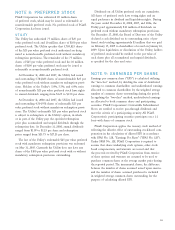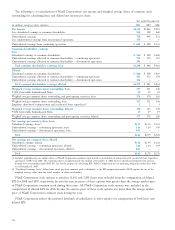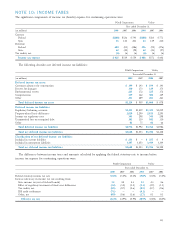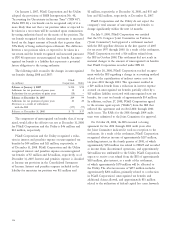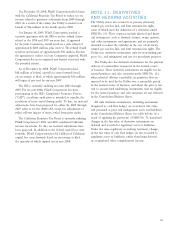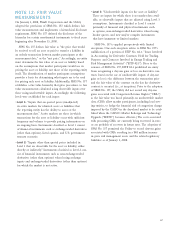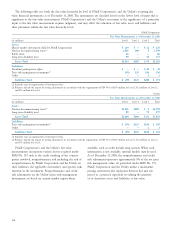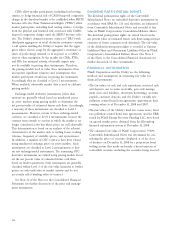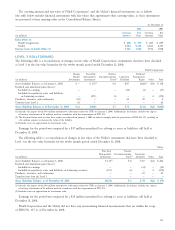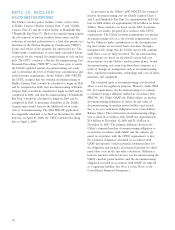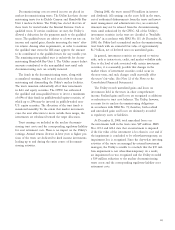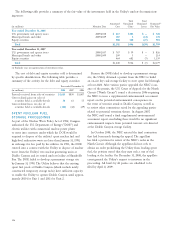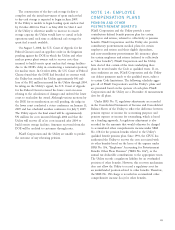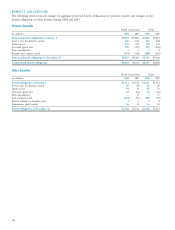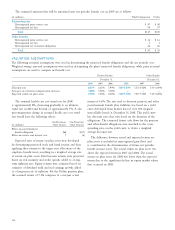PG&E 2008 Annual Report Download - page 122
Download and view the complete annual report
Please find page 122 of the 2008 PG&E annual report below. You can navigate through the pages in the report by either clicking on the pages listed below, or by using the keyword search tool below to find specific information within the annual report.120
DIVIDEND PARTICIPATION RIGHTS
The dividend participation rights of the Convertible
Subordinated Notes are embedded derivative instruments in
accordance with SFAS No. 133 and, therefore, are bifurcated
from Convertible Subordinated Notes and recorded at fair
value in PG&E Corporation’s Consolidated Balance Sheets.
The dividend participation rights are valued based on the
net present value of estimated future cash fl ows using internal
estimates of future common stock dividends. The fair value
of the dividend participation rights is recorded as Current
Liabilities-Other and Noncurrent Liabilities-Other in PG&E
Corporation’s Consolidated Balance Sheets. (See Note 4
of the Notes to the Consolidated Financial Statements for
further discussion of these instruments.)
FINANCIAL INSTRUMENTS
PG&E Corporation and the Utility use the following
methods and assumptions in estimating fair value for
fi nancial instruments:
• The fair values of cash and cash equivalents, restricted cash
and deposits, net accounts receivable, price risk manage-
ment assets and liabilities, short-term borrowings, accounts
payable, customer deposits, and the Utility’s variable rate
pollution control bond loan agreements approximate their
carrying values as of December 31, 2008 and 2007.
• The fair values of the Utility’s fi xed rate senior notes, fi xed
rate pollution control bond loan agreements, and the ERBs
issued by PG&E Energy Recovery Funding LLC, were based
on quoted market prices obtained from the Bloomberg
fi nancial information system at December 31, 2008.
• The estimated fair value of PG&E Corporation’s 9.50%
Convertible Subordinated Notes was determined by con-
sidering the prices of securities displayed as of the close
of business on December 31, 2008 by a proprietary bond
trading system that tracks and marks a broad universe of
convertible securities including the securities being assessed.
CRRs allow market participants, including load serving
entities, to hedge fi nancial risk of CAISO-imposed congestion
charges in the day-ahead market to be established when MRTU
becomes effective. Firm Transmission Rights (“FTRs”) allow
market participants, including load serving entities, to hedge
both the physical and fi nancial risk associated with CAISO-
imposed congestion charges until the MRTU becomes effec-
tive. The Utility’s demand response contracts (“DRs”) with
third-party aggregators of retail electricity customers contain
a call option entitling the Utility to require that the aggre-
gator reduce electric usage by the aggregator’s customers at
times of peak energy demand or in response to a CAISO
alert or other emergency. As the market for CRRs, FTRs,
and DRs has minimal activity, observable inputs may
not be available in pricing these instruments. Therefore,
the pricing models used to value these instruments often
incorporate signifi cant estimates and assumptions that
market participants would use in pricing the instrument.
Accordingly, they are classifi ed as Level 3 measurements.
When available, observable market data is used to calibrate
pricing models.
Exchange-traded derivative instruments (other than
options) are generally valued based on unadjusted prices
in active markets using pricing models to determine the
net present value of estimated future cash fl ows. Accordingly,
a majority of these instruments are classifi ed as Level 1
measurements. However, certain of these exchange-traded
contracts are classifi ed as Level 2 measurements because the
contract term extends to a point at which the market is no
longer considered active but where prices are still observable.
This determination is based on an analysis of the relevant
characteristics of the market such as trading hours, trading
volumes, frequency of available quotes, and open interest.
In addition, a number of OTC contracts have been valued
using unadjusted exchange prices in active markets. Such
instruments are classifi ed as Level 2 measurements as they
are not exchange-traded instruments. The remaining OTC
derivative instruments are valued using pricing models based
on the net present value of estimated future cash fl ows
based on broker quotations. Such instruments are generally
classifi ed within Level 3 of the fair value hierarchy as broker
quotes are only indicative of market activity and do not
necessarily refl ect binding offers to transact.
See Note 11 of the Notes to the Consolidated Financial
Statements for further discussion of the price risk manage-
ment instruments.



